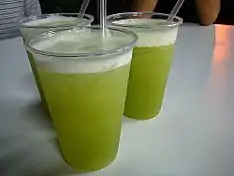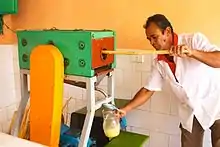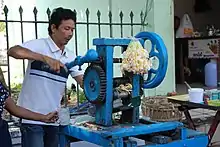Sugarcane juice
Sugarcane juice is the liquid extracted from pressed sugarcane. It is consumed as a beverage in many places, especially where sugarcane is commercially grown, such as Southeast Asia, the Indian Subcontinent, North Africa, and Latin America. Sugarcane juice is obtained by crushing peeled sugar cane in a mill and is one of the main precursors of rum.


In the United States where processed sugarcane syrup is used as a sweetener in food and beverage manufacturing, "evaporated cane juice" is considered by the Food and Drug Administration (FDA) to be a misleading term for "sugar" on product labels because the FDA regards "juice" as a liquid derived from fruits or vegetables; the preferred term is "cane sugar".[1][2]
Health risks
Raw sugar cane juice can be a health risk to drinkers due to the unhygienic conditions under which it is prepared in some countries with lower health standards. There are some diseases that can be transmitted by raw sugar-cane, such as Leptospirosis.[3] In Brazil, sugarcane juice has been linked to cases of Chagas disease, as sugarcane can contain traces of its responsible pathogen, Trypanosoma cruzi, left by infected bugs if not properly cleaned.[4]
Drinking sugarcane juice in Egypt may pose health risks due to contamination with the mycotoxins, aflatoxin B1 and fumonisin B1.[5][6]
Labeling as "cane sugar"
In food and beverage manufacturing where cane sugar is used to sweeten consumer products, such as in the United States where the FDA regulates the description of ingredients on food labels, the term "sugarcane juice" cannot be used because it misleads consumers to believe that cane juice is similar to fruit or vegetable juices.[2] Instead, the FDA recommends "cane sugar" or another term determined by manufacturers who should "review the final guidance and consider whether their labeling terminology accurately describes the basic nature and characterizing properties of the sweetener used".[1]
Countries
Burma (Myanmar)

In Burma (Myanmar), sugarcane juice is called kyan ye (ကြံရည်) and is available throughout the country.[7] It is typically brewed during the summertime, and optionally blended with lime, jujube, or orange.[8]
Egypt
In Egypt, sugarcane juice is known as asab and is sold in juice shops around the country. The largest juice shop in Egypt is in Saft El Laban, Giza. Egyptians also mix lemon with asab and let it ferment to produce a fermented variant of the drink. The most highly prized asab comes from Minya, Egypt.[9]
India
Sugarcane juice is sold by street vendors throughout India. The vendors put the sugarcane in a machine, which presses and extracts the sugarcane juice out. Sugarcane juice is usually served with a dash of lime and/or ginger juice.[10]
Indonesia
_seller.JPG.webp)
In Indonesia, sugarcane juice drink is called minuman sari tebu. The iced sugar cane juice is called es tebu.[11] In Indonesian, tebu is sugarcane and es is ice. It is one of the traditional beverages commonly sold street-side in Indonesia.[12] The sugarcane plant has been cultivated in Java since ancient times. The earliest record comes from a 9th-century inscription, dated from the Medang Mataram period, that describes a sweet drink called Nalaka Rasa, which translates as "sugarcane juice".[13]
The juice is extracted using a pressing machine to squeeze the sugary sap from sugarcane. The machine might be human-powered, or powered by a gasoline engine or electricity. The juice sold there is always served cold with ice cubes. Traditionally, it is sold throughout the country, especially among street vendors that set their stall on the street side. However, today sugarcane drink vendors with much-improved hygiene can also be found in foodcourts in malls and shopping centers.[14]
Brazil
Like India, sugarcane juice is sold in the streets of Brazil, using the same process of putting the sugarcane in a machine, which presses and extracts the sugarcane juice out. It is sometimes served with lemon or pineapple juice.
Madagascar
In the eastern region of Madagascar, sugarcane juice is fermented to make an inexpensive alcoholic beverage called betsa-betsa. The drink is popular with locals because it is cheaper than beer.[15]
Pakistan
The government of Pakistan has declared sugarcane juice as the country's national drink.[16]
Vietnam
Sugarcane juice, called nước mía or mía đá, is common in Vietnam as a drink. Other fruit juices may be added to balance the sweetness, such as kumquat[17] or chanh muối. It is sold at street stalls in plastic bags filled with ice or in disposable plastic cups.[18]
See also
References
- "Federal Register: Ingredients Declared as Evaporated Cane Juice; Guidance for Industry; Availability". Center for Food Safety and Applied Nutrition, US Food and Drug Administration. 25 May 2016. Retrieved 22 August 2019.
- "Ingredients Declared as Evaporated Cane Juice: Guidance for Industry". Center for Food Safety and Applied Nutrition, US Food and Drug Administration. 1 May 2016. Retrieved 22 August 2019.
- Fisheries, Agriculture and. "Leptospirosis". Business.qld.gov.au. Retrieved 1 November 2018.
- "Perguntas frequentes". Fundação Oswaldo Cruz (in Portuguese). Archived from the original on 2017-08-15.
- Abdallah, Mohamed F.; Krska, Rudolf; Sulyok, Michael (2016). "Mycotoxin Contamination in Sugarcane Grass and Juice: First Report on Detection of Multiple Mycotoxins and Exposure Assessment for Aflatoxins B1 and G1 in Humans". Toxins. 8 (11): 343. doi:10.3390/toxins8110343. PMC 5127139. PMID 27869706.
- Abdallah, Mohamed F.; Audenaert, Kris; Lust, Leonie; Landschoot, Sofie; Bekaert, Boris; Haesaert, Geert; De Boevre, Marthe; De Saeger, Sarah (1 February 2020). "Risk characterization and quantification of mycotoxins and their producing fungi in sugarcane juice: A neglected problem in a widely-consumed traditional beverage". Food Control. 108: 106811. doi:10.1016/j.foodcont.2019.106811.
- "နွေရာသီနဲ့ လိုက်ဖက်တဲ့ သဘာဝ ကြံရည် သောက်ခြင်းရဲ့ ကျန်းမာရေး ကောင်းကျိုး ၆ ခု". ဧရာဝတီ (in Burmese). 2018-03-15. Retrieved 2021-01-12.
- "နွေရာသီနဲ့ ကြံရည်". MyFood Myanmar (in Burmese). Retrieved 2021-01-12.
- Bruce Kraig; Colleen Taylor Sen (2013). Street Food around the World. ABC-CLIO. p. 130. ISBN 978-1598849554.
- Monisha Bharadwaj (16 July 2018). Indian Cookery Course. Octopus Books. pp. 1093–. ISBN 978-0-85783-593-2.
- "Kisah di Balik Segarnya Minuman Es Tebu". CNN Indonesia (in Indonesian). Retrieved 2017-11-15.
- W, Rian Yulianto. Minuman Tradisional Indonesia (in Indonesian). Gulajava Ministudio. p. 36.
- Widjanarko, Tulus. "Hanya Ada Di Candi Sojiwan: Menu Hidangan Raja Mataram Kuno". Tempo (in Indonesian). Retrieved 2017-11-15.
- Mediatama, Grahanusa. "Menyedot laba manis minuman tebu". kontan.co.id (in Indonesian). Retrieved 2017-11-15.
- Bradt, Hilary; Austin, Daniel (1 July 2014). Madagascar. Bradt Travel Guides. ISBN 9781841624983 – via Google Books.
- "Govt declares sugarcane juice as 'national drink' of Pakistan". The Nation. 25 January 2019. Retrieved 10 February 2019.
- "Sweetest at the throat". 30 March 2010. Retrieved 7 November 2011.
- "Nuoc mia, or sugar-cane juice". 6 November 2008. Retrieved 7 November 2011.
